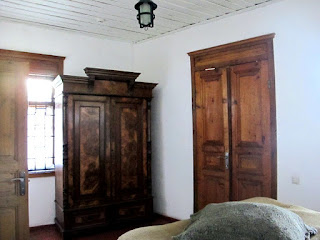The grand lobby of the Araks hotel in Gyumri.
The enormous dining room of the Araks hotel where we dined in solitary splendour.
The monastery of Haghartsin near Dilijan.
View from our room in the heritage hotel in Dilijan.
Some of the old furniture in our hotel room in Dilijan.
In the morning the sun had come out and we set off going first to Lake Sevan where we visited a little old church at Hayahavank dating from the 9th and 10thC. Armenian churches contrast markedly with those of Georgia. There are no icons and no iconostasis- the altar is in plain view and surmounted with a cross which maybe ornately carved/decorated. Since the 19thC it has become customary to place a painting of the Virgin and child behind the cross, but Mary's face should look Armenian. The rather austere interiors suits my protestant upbringing. The rule for women covering their hair seems only to be enforced if a service is actually in progress.
The 9th-10thC church of Hayahavank on Lake Sevan.
Fishermen on Lake Sevan.
General view of the medieval cemetery at Noraduz. All the khashkars face west. We were there in the morning so photography was difficult.
As well as crosses the tombstones show scenes of daily life, such as this one of a man ploughing.
Some of the local women were selling their knitting among the tombstones.
One of the knitters. My friends who know of my phobia of graveyards would have been surprised to find me unconcernedly clambering among the tombstones and even pulling away the grass to get a better photo, but if the graves are more than about 300 years old I can cope.
On then over the Selim Pass, which was on the Silk Road and near the top of the pass is the well preserved Selim Caravanserai.
Three Armenian children from a summer encampment near the Selim Pass. The locals bring their sheep and cattle up into the mountains to graze the alpine meadows.
Alpine meadow.
The entrance to the Selim caravanserai.
Interior of the Selim caravanserai.
The road continues on past Sisian and near there is Karahunj, an Armenian Stonehenge. In the grounds of the Sisian museum are some petroglyphs and also gravestones in the form of carved sheep.
Lots of roadside stalls selling particularly mushrooms and asparagus. I bought cherries at about $2/kg.
The Armenian Stonehenge at Karahunj
Several of the stones have holes, but it is not clear how they line up or the actual purpose.
On Monday we were supposed to take the cable car to the Tatev monastery but it does not run on Mondays, so we went instead to Khndzoresk a cave city carved in the tufa pillars rather like in Cappodocia in Turkey. Although it was abandoned in the 19thC, during the recent war with Azerbaijan, Goris was shelled and some people retreated to the caves for safety.
Sheep gravestones now in the grounds of Sisian museum.
Another pastoral scene near Goris.
A general view of the cave city of Khndzoresk.
We also inspected a lavash bakery in Goris. Traditionally the baking is done by women and they work efficiently together as a team.
Rolling out the dough.
Here you can see the whole process. After rolling, the dough is spread on an oblong pad and stuck to the wall of the underground oven (rather like an Indian tandoori oven) It cooks very quickly as it is thin. It is then retrieved and spread out to cool. If kept dry it keeps for about six months.
I thought I would like a photo of the shop dummies outside a shop (general store) in Goris and Angelina and her Mum raced to be in the picture.
I thought I would like a photo of the shop dummies outside a shop (general store) in Goris and Angelina and her Mum raced to be in the picture.

























I can smell the bread from here. Stunning scenery and yes, Kate, I can see you clambering amongst the graves. Did you buy any of the knitted sox? You might need them when you come back to winter.
ReplyDeleteI did buy a pair of gloves
DeleteLove those sheep gravestones! It would make a cemetery just look like a sheep paddock if everyone had them.
ReplyDeleteKate, loving the vicarious travelling with you! They've certainly got you doing lots of things in a day. Your photos are taking me back & I'm making notes on the bits we missed (sheep graves etc) for our next trip. Have you found Dolmama?
ReplyDeleteHilary & Raffi